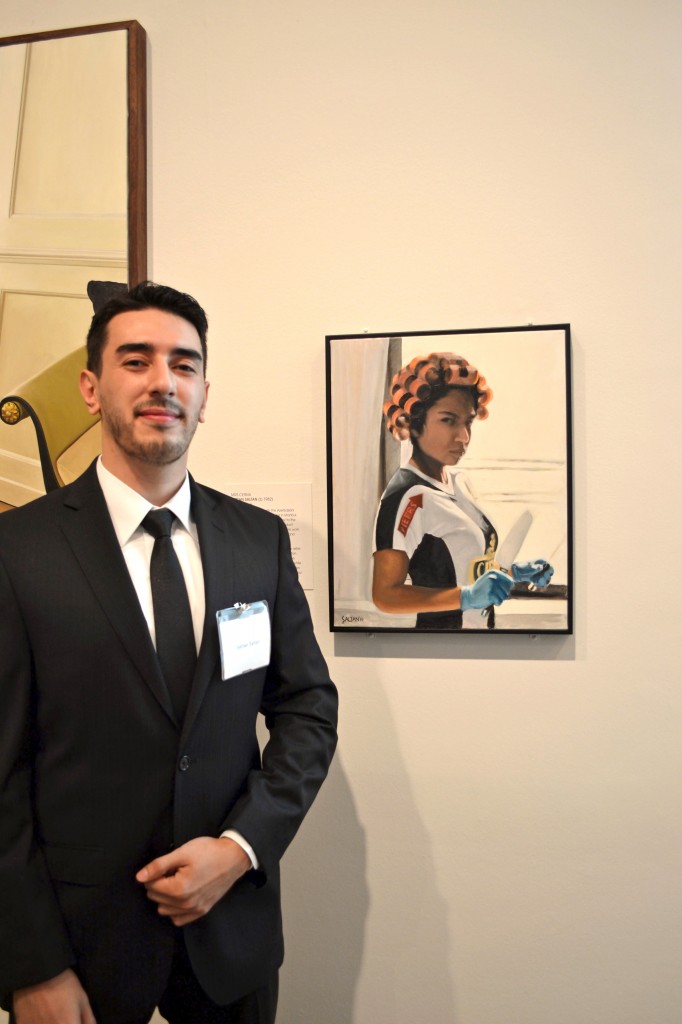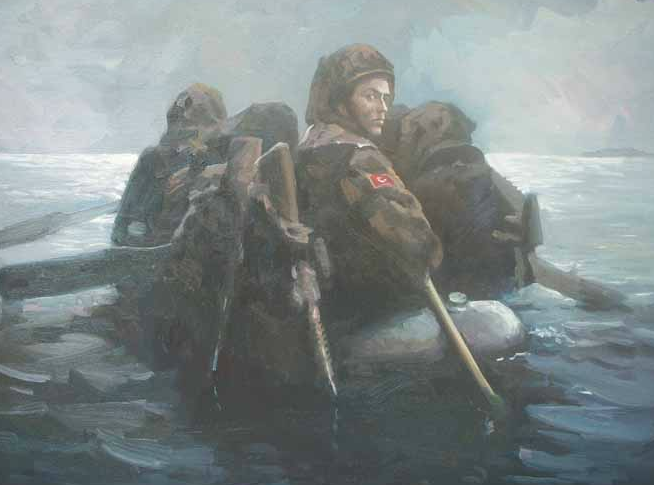A buxom young woman is holding a big kitchen knife in her dainty rubber sheathed hands. Her hair is in tight rows of curlers and she’s wearing a sports jersey, yet the expression on her face – a mix of confidence and chastened warning – is what you would expect to see on a pop star giving a bit of attitude on stage. Sertan Saltan captured the tension between this odd domesticity and the wavering confidence of a young woman to perfection with Mrs Cerna and it won him this year’s BP Young Artist Prize.
Between his native Turkey and New York, where he studied, his influences are a collage of different cultures and different periods that come together in a uniquely insightful approach to portraiture. He took a few minutes out of his holiday (lucky readers!) to answer our questions about his work…
aqnb: Hi Sertan. First of all, why did you become a painter?
Sertan Saltan: I think this is something you are born with. It is your soul, your existence and how you see the world. Just like music, every object you look at, every situation you experience is in a harmony to an artist’s eye. When you’re a kid you don’t know why but, you’re different from the others, you are not happy when things look ugly and inharmonious.
You want to make things, build things and picture them. It is part of you, and your inner voice is telling you that this is your duty, what you enjoy and what you want to do for the rest of your life. You have your brush and your canvas, and it is yourself and the rest of the universe that you can play and experiment with. The things that you can do is unlimited, the joy of creating new paintings is indescribable and I think that is why I became an artist. It is something you’re born with and this interest in fine arts shows itself in many different ways. For example i do like cinematography very much and I am trying to learn how to shoot short films. I still have a long way to go but it is an area that I would love to explore further.
aqnb: And why specializing in in portraiture?
S.S.: When I started my painting training in Istanbul, I was a new artist who was painting anything and everything without any discrimination, from landscapes to still life and illustrative to photo realistic. It was a part of finding my true self.
However, I’ve always had a big attraction to the human figure. I think it is the most relatable type of painting. When it comes to portraiture you enter into a very different world, a world of someone else. It is pretty much like writing a biography, you tell many things about your subject in one single painting, capturing the moment not through a machine’s processor but through your mind and heart. When I realized the importance and the true meaning of portraiture, i decided to pursue my passion towards that direction.
aqnb: Portraiture is an artistic practice with a lot of history. Are you inspired/influenced by any period or artist in particular?
S.S.: During my art education I was extremely attracted to the Baroque period. The contrast in light and shadow and the realism was absolutely mesmerizing. However, I started to lose my interest in the baroque art and started to discover American illustrative art which back then wasn’t seen as real art by many established artists. I discovered a forgotten artist: JC Leyendecker, his expertise in figure painting without relying on any photography but painting only from live sittings made me examine his art style even further.He never worked from a photograph and he had the perfect human anatomy knowledge to produce gorgeous paintings.
However, illustrative art wasn’t my style and I moved on with the valuable knowledge that i got from studying Leyendecker paintings. I started to experiment with different subjects but it didn’t go beyond boring fire place portraits. Soon i realized what was missing. I had to include the subject in the painting!

Did it sound silly? Yes I know but that’s the truth, including subject is not only painting a sterile human figure but his or her soul and glimpse of their lives. That is one big challenge for me and many young artists around the world but I think I am getting there slowly. I reached to a point that, I am pretty confident with my own style.
aqnb: How do you find your subjects?
S.S.: This question makes me smile because it is one painful process. I am an absolute nitpicker. I go through the process of offers and rejections of potential subjects. I hate to tell them they’re not interesting enough but this is how things work for me. I always believe that a subject has to be able to communicate with me with his or her image.
Because in each of my paintings I strive to communicate with the viewer and if my subject doesn’t communicate with me, I don’t think there is any chance that subject actually can communicate with the audience.

aqnb: How do they react to the final portrait?
S.S.: Well, I don’t show a painting until it is fully finished and they usually end up seeing it through their emails. Sometimes they think it is like a photograph which is totally not what I aim for, and sometimes they tell me what their family thinks about the painting and it is always fun to hear different comments. All in all, I have never had any disappointed subjects.
aqnb: What is your process (sittings, photographs, duration)?
S.S.: I work from sittings, and i need at least three sittings. I hate working from photographs and only use them if my subject canʼt sit for me anymore. I use it as references such as skin colors etc. I think there is no point of transferring a photo on to your canvas. It is really silly, and I think an artist should study from real sittings. Drawing and sketching is the foundation of a good portrait. I sketch my subject first and transfer it on to canvas, this allows me to get familiar with my subjects facial futures as well. Eventually I can finish a portrait within a month.
aqnb: What would you say makes your work recognizable?
S.S.: Definitely the story telling aspect of it. When i complete a painting it is no more mine but the viewers. It communicates and tells about the subject, his or her life and why they were painted. Contemporary classic is the right word for my style i think. I also have broad and flexible brush strokes that differentiates me from very photorealist, number zero brush using painters.
aqnb: How do you believe your approach to portraiture contributes to the definition of beauty or reality?
S.S.: Beauty is in the eye of the beholder. So my approach to the portraiture is pretty much in line with that statement. I do not put extra effort to make people look more flattering to the eye. On the other hand I don’t paint them grotesquely realistic either. My works are usually the reflection of my subjects true self. I want the viewer to be able to focus on the individual not on the style of the painting. Some fellow artist like to paint every single detail on someone’s face and when you hear people in front of a painting talking about the veins on the subjects forehead, it is not really a portraiture to me.
I want my paintings to be talked about with their story telling aspect of it and this is totally my objective.
aqnb: Have you had the experience of sitting for a portrait of your own or have you ever created self-portraits?
S.S.: I had my portrait painted once by my teacher many years ago. Honestly sitting for someone is not the easiest thing and I really appreciate the patience of my models. I have recently made a quick self portrait of mine, and am happy with the result. I like hearing my friends comments about it and I really had quite a fun painting it even though my neck hurt after every session looking at the mirror.
aqnb: Thanks for your time Sertan!


















